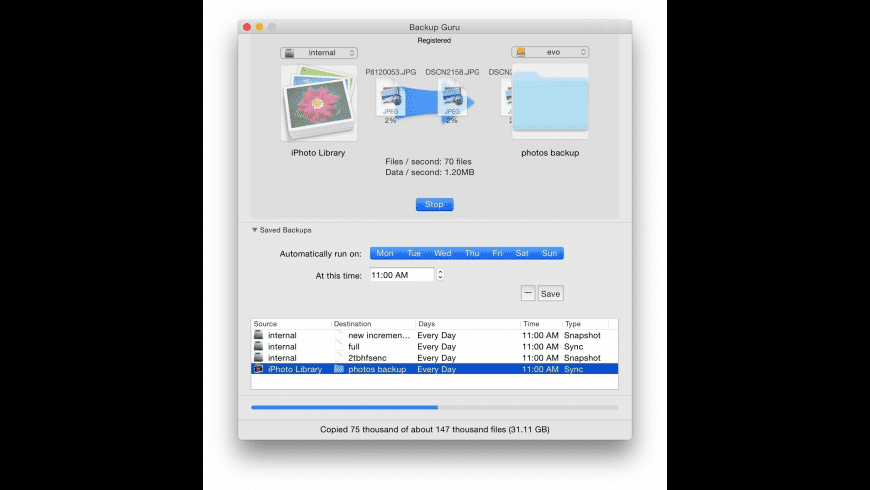Mac Backup Guru is the easiest to use clone, sync, and snapshot app for OS X. Mac Backup Guru has 3. Mac Backup Guru i. Backup Guru has 3 main functions: Direct Cloning, Synchronization, and Incremental. It works as a web app and for both iOS and Android devices. It is an intelligent app that learns your contacts, schedule and tasks. It also helps you schedule and arrange meetings according to your available time slots. A good thing about Calendar is that it allows you to sync up with other calendars you use such as Apple Calendar and Google. Backup List is the incremental backup software provided by MacUpdate. It is simple, fast, and accurate application for OS X. It is also wrapper application for sync 3.0.8 and can perform as incremental backup Linux besides Mac operating system. During those five years, Apple might get $29 two or three times for updates to Mac OS X; Dell gets nothing from any Windows upgrades. Apple may also now reap additional dollars from Mac App Store purchases, too. The Android ecosystem has the same trouble as desktop and laptop computers. From a coding point of view, it's very easy to use a framework that runs on both. But the problem is the entry cost for iOS development that is quite high if you don't already own Apple devices. You need a Mac computer to compile/package and an iPhone to test, plus the registration fee for the App Store which is higher than Google Play Store. How to Back Up Your Computer with Time Machine. Mac macOS (10.5 and above) has an excellent built-in backup tool called Time Machine. Once you plug in a hard drive and set up Time Machine, it will work automatically in the background, continuously saving copies of all your files, applications, and system files (i.e., most everything except for the stuff you likely don’t need to back up, such.
Have you ever had trouble finding a photo and feared the worst — that you accidentally deleted it? Or maybe you’ve heard a friend bemoan of how their hard drive failed and they lost everything from pictures of their firstborn to that once-in-a-lifetime selfie with Michael Jordan?
After taking a moment to realize how fortunate you’ve been to have not lost any pics yourself, you probably think, “I should start backing up my photos.” Well, you’ve found the right article. We’re going to go through a few solutions for backing up your Mac and, more specifically, your photo collection. Because while losing an important piece of work is tragic, it’s usually replaceable. The moments that your pictures represent are fleeting, and there’s no way to recreate them.
There’s truth in the phrase 'garbage in, garbage out'. So before you even ask yourself, “How do I back up my photos?” you’ll want to make sure your photo library is cleaned up. Space is precious, so backing up duplicate and almost-duplicate pictures will be a waste.

Thankfully, a Mac app like Gemini 2 can help you unclutter your photos before you back them up. And the best part is, you can download it for free to give it a try.
Best ways to back up your photos on Mac
As mentioned earlier, there are a couple ways to go about backing up your photos. The ones we’re going to go over are:
- iCloud
- Time Machine
- Google Photos
- External hard drive
After reading this article, you’ll be able to weigh out the cost versus convenience for each of these options and see which one works best for you. At the end of the day, the best way to backup photos is the one that’s easy for you to use on a regular basis.
1. How to backup photos to iCloud
The first method is the one that comes standard with your Mac and doesn’t require you to install any additional software. iCloud is cloud-based storage made by Apple and available to anyone with an AppleID. Using iCloud to backup photos is easy thanks to automatic backups and syncing, built into both iPhone and Mac. All you have to do is make sure iCloud is turned on on each device, and you’re all set.
The catch, as there always is, is that you only get 5 GB for free. And that includes not only photos, but also anything else you decide to store on your iCloud drive. Additional storage can be purchased and is fairly affordable compared to other cloud storages.
Setup iCloud Photos backup
When you backup your photos to iCloud, not only does it save your pictures to the cloud, but it also saves them on all of your devices. Since we’re talking mainly about your Mac in this article, you can follow the steps below to see how to save iCloud Photos to your Mac:
- Go to System Preferences > iCloud.
- Click Options next to Photos.
- Select iCloud Photos.
After you turn on iCloud Photos, you’ll get access to other options for syncing and sharing your photos.
This might be helpful: The beginner’s guide to iCloud Photo Sharing
2. How to backup photos to Time Machine
The next type of backup veers away from the cloud-based model. Time Machine is the built-in Mac application that will automatically backup your Mac to an external hard drive. Which means you will have to buy an external drive or use a network drive, but the bright side is as long as you have the hard drive plugged in your Mac will be backed up.
One of the major benefits to Time Machine is that it’s a differential backup. That means that after the initial backup it will only back up the files that are new and/or changed. So every backup after the first one will be faster because, in theory, it’s backing up fewer files.
Does Time Machine back up my photo library?
There can be some confusion as to what Time Machine backs up once it’s configured. Simply put, it backs up everything, including any photos stored on your Mac.
That being said the easiest way to search for photos and/or restore things from your backup is to ensure you’re using the Photos app on your computer. If you just have random photos scattered throughout your Mac it can be harder to track those down, whereas Photos helps you keep your library organized.
Setup Time Machine backup
Because Time Machine backs up everything on your computer, any duplicates you have taking up space on your computer’s hard drive will also waste space in your backup. The Mac app, Gemini 2, can scan your hard drive to help you quickly find and remove duplicate files.
Once you plug an external hard drive into your Mac, you should be automatically prompted to use the drive with Time Machine. If you’re not, you can do it manually:
- Go to Apple > System Preferences > Time Machine.
- Click Select Disk.
- In the Time Machine preferences window, select your external drive from the list of available disks.
- Then click Use Disk.
If the hard drive is not formatted properly to be used with Time Machine, you’ll be prompted to format it. You’ll also notice an option to encrypt the hard drive and your backup, which adds an extra level of security in case you misplace the external drive.

An Incremental Mac App Download
3. How to backup photos to Google Photos
The next option is another cloud-based backup solution, Google Photos. While not as well-integrated into iPhone and Mac as iCloud, Google Photos offers equally easy setup and ongoing backups.
The biggest difference between Google Photos and iCloud though is that with Google Photos you can store an unlimited amount of pictures — as long as you agree to have those photos compressed. While most people won’t notice the difference between compressed and uncompressed photos, it’s still something worth noting. If you choose to upload your images at full quality, you’ll be using your Google Drive space, of which you get 15GB for free. Additional storage can be purchased.
Setup Google Photos to backup pictures
Like iCloud, Google handles backups on a per-device basis, but in this case we’ll be covering how to set up a Google Photos backup on Mac:
- Download and install the Google Backup and Sync app on your Mac
- Sign in with your Google Account
- Select whether to back up only photos or videos or all files
- Select all folders you want to back up
- Under “Photo & video upload size,” select your upload quality
- Click Start
An Incremental Mac App Software
This might be helpful: Best photo sharing sites you can use for free
4. Backup photos to an External hard drive
This last option will definitely take the most manual labor. On the other hand, using an external hard drive will give you the most control over what you’re backing up, and many prefer to have it the old-fashioned way. Whether you’re using Photos, another photo manager, or just have pictures scattered around your Mac, you’ll be able to back them up. It’ll just take you a little bit of time to do it yourself.
Of course, if you have iCloud turned on your Mac, you can also backup your iCloud photos to an external hard drive as a secondary back up.
How to back up Photos Library to an external hard drive
- Open Finder > Pictures (or wherever your images are)
- Select your Photos Library, the folder you want to back up, or individual files
- Drag and drop the file onto your external hard drive in the left column.
While this method gives you the most freedom and assurance that you’re backing up exactly what you want, if you make any changes to your Photo Library on Mac, you’ll have to back it up all over again.
As you back up and re-back up photos to an external drive, eventually you might find it riddled with duplicates. Gemini 2, the Mac app we mentioned earlier, can also scan your external HDD for duplicate photos, making it easy to delete them.
Now that you’ve got some idea on how to back up your photos, it’s time to get started. The most important thing to keep in mind is that a backup is only as good as the last time it was done. So back up your pictures early, and back them up often. And if you’re truly worried about it — why only have just one photo backup? Combine a cloud-based option with an external HDD and sleep well knowing your memories are safe.